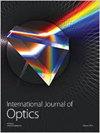Refractometric Sensing of Protein in Urine by the Photonic Crystal Fiber Biosensor in THz Regime
IF 1.8
4区 物理与天体物理
Q3 OPTICS
引用次数: 0
Abstract
The presence of albumin in human urine is one of the confirmed early symptoms of kidney dysfunction. A precise urine protein identification process is very important to monitor the kidney’s proper functioning. To identify the presence of albumin in urine, a refractometric protein sensing approach in the photonic crystal fiber (PCF) environment has been introduced here. A PCF geometry with suspended cladding and a circular hollow core has been proposed and investigated in the terahertz (THz) spectrum for protein identification in the liquid samples. Three levels of albumin concentrations in urine (7–125 mg/dl, 250–500 mg/dl, and 1000 mg/dl) are considered to evaluate the sensing performances of the proposed PCF. The numerical investigations are performed on the COMSOL Multiphysics platform where the finite element method (FEM) figures out the numerical outcomes. The performances of the proposed PCF exhibit highly sensitive characteristics for albumin identification in the different albumin concentration levels of urine. The sensitivity shows more than 98.5% for all the tested concentration levels due to the strategic selection of geometrical parameters and proper optimization. Alongside, negligible confinement loss of 10−16 cm−1 is attained at the same operating point of 4.3 THz. Furthermore, dispersion profiles and practical implementation strategies are also investigated and discussed in detail.光子晶体光纤生物传感器在太赫兹波段对尿液中蛋白质的折射传感
尿中存在白蛋白是肾脏功能障碍的早期症状之一。精确的尿蛋白鉴定过程对监测肾脏的正常功能非常重要。为了确定尿液中白蛋白的存在,本文介绍了一种在光子晶体光纤(PCF)环境下的折射蛋白传感方法。在太赫兹(THz)光谱中,提出并研究了一种具有悬浮包层和圆形空心核心的PCF几何结构,用于液体样品的蛋白质鉴定。三种水平的尿液白蛋白浓度(7-125 mg/dl, 250-500 mg/dl和1000 mg/dl)被认为是评估所提出的PCF的传感性能。在COMSOL多物理场平台上进行了数值研究,并采用有限元法计算了数值结果。所提出的PCF在尿液中不同白蛋白浓度水平的白蛋白鉴定中表现出高度敏感的特性。通过几何参数的合理选择和优化,对所有浓度水平的灵敏度均大于98.5%。此外,在4.3太赫兹的相同工作点上,可忽略不计的约束损失为10−16 cm−1。此外,还详细研究和讨论了分散特性和实际实现策略。
本文章由计算机程序翻译,如有差异,请以英文原文为准。
求助全文
约1分钟内获得全文
求助全文
来源期刊

International Journal of Optics
Physics and Astronomy-Atomic and Molecular Physics, and Optics
CiteScore
3.40
自引率
5.90%
发文量
28
审稿时长
13 weeks
期刊介绍:
International Journal of Optics publishes papers on the nature of light, its properties and behaviours, and its interaction with matter. The journal considers both fundamental and highly applied studies, especially those that promise technological solutions for the next generation of systems and devices. As well as original research, International Journal of Optics also publishes focused review articles that examine the state of the art, identify emerging trends, and suggest future directions for developing fields.
 求助内容:
求助内容: 应助结果提醒方式:
应助结果提醒方式:


